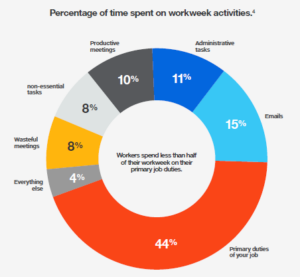
By Michael Conlin, Marketing Communications Director
In one of my favorite poems, “To be of use,” Marge Piercy writes: “the pitcher cries for water to carry and a person for work that is real.”
The point of the poem is that work is meaningful. It is best when we “submerge” into it—bringing our full talent, experience, and energy to produce something of substance. It can be “common as mud.” It can be arduous. Even tedious. But if it is worth doing and productive, than it is good.
Unfortunately, a too common problem in today’s workplace is that busywork is confused with real work.
Busywork isn’t real work
Busywork is high volume, repetitive tasks that do not require complex, logical decision making.
 For most of us, busywork feels meaningless. It does not engage us in ways that make us feel productive, which causes frustration. Yet according to Adobe Workfront’s “The State of Work Report 2019,” most of us spend more time doing busywork than the actual job we were hired to do.
For most of us, busywork feels meaningless. It does not engage us in ways that make us feel productive, which causes frustration. Yet according to Adobe Workfront’s “The State of Work Report 2019,” most of us spend more time doing busywork than the actual job we were hired to do.
The results are not positive. Busywork in the workplace leads to:
- Worker dissatisfaction
- Lost productivity
- Errors and inaccuracies in data
- Inefficient processes
The more we repeat a task, the less we think about it. If organizations want workers to think creatively and strategically to drive innovation, then they need their workers to engage their minds more—not shut them off.
Busywork can be outsourced—to busy bots
Just because busywork feels pointless doesn’t mean it is. Many of these routine, repeatable tasks are actually important for how businesses collect, share, and interpret data.
In today’s competitive business landscape, data is an invaluable resource. The more we know about our customers, how they interact with our products and services, and what their experience is, the better we can serve their needs and make decision about how to grow our business. This is one of the powers of modern technology.
Robotic Process Automation (RPA) is another power of modern technology. A human doesn’t have to do the busywork. A software robot (bot) can.
A bot is not an actual physical robot. It is software that is programmed to replace manual work done by human workers—faster and with greater accuracy.
Bots are perfect for extracting data and filling out forms, reading and sending emails, interfacing with different applications, categorizing and storing customer data, and more.
Real-life RPA examples
Let’s take a common business function: accounts payable and the processing of invoices. Traditionally, this requires a worker to upload data into an enterprise resource planning (ERP) system, such as SAP. Many of these invoices are non-standard, meaning they could be paper documents, faxes, or PDFs filled with unstructured or semi-structured data in different formats. RPA can interpret these invoices and pick out key information for processing using optical character recognition and machine learning models.
In a healthcare system, automation opportunities have been found throughout the revenue cycle. Insurance companies use RPA to process claims and invoices—often across a combination of legacy and modern systems—without human input. Mortgage lenders use it to reduce mistakes and delays with appraisals. Other businesses use it for order processing, data migrations, exceptions processing, account reconciliations, onboarding/offboarding, benefits administration, and much more.
Jump into work headfirst
RPA lets organizations rework how its people work. It let’s us use technology as it was intended—to accomplish more, easier, without error, and at a quicker pace.
Equally if not more important, RPA empowers people to do more interesting and meaningful work. It opens new possibilities and opportunities. In the words of Marge Piercy, it lets us get back to doing work we were made to do…work that is real…and work that promotes growth.
About Garnet River
Founded in 2000 and based in Saratoga Springs, N.Y., Garnet River provides comprehensive and flexible staffing and staff augmentation services, innovative robotic process automation (RPA), and managed outsource solutions to public- and private-sector clients. Garnet River is a partner with UiPath, Microsoft, Cisco Meraki, Hewlett Packard Enterprise, and others. For more information, visit garnetriver.com.
Subscribe to The River's Bend
The River's Bend is our monthly newsletter, featuring insights into what you should be looking for in business and technology before it can be seen...so you can prepare, act, and ultimately navigate a path forward.


